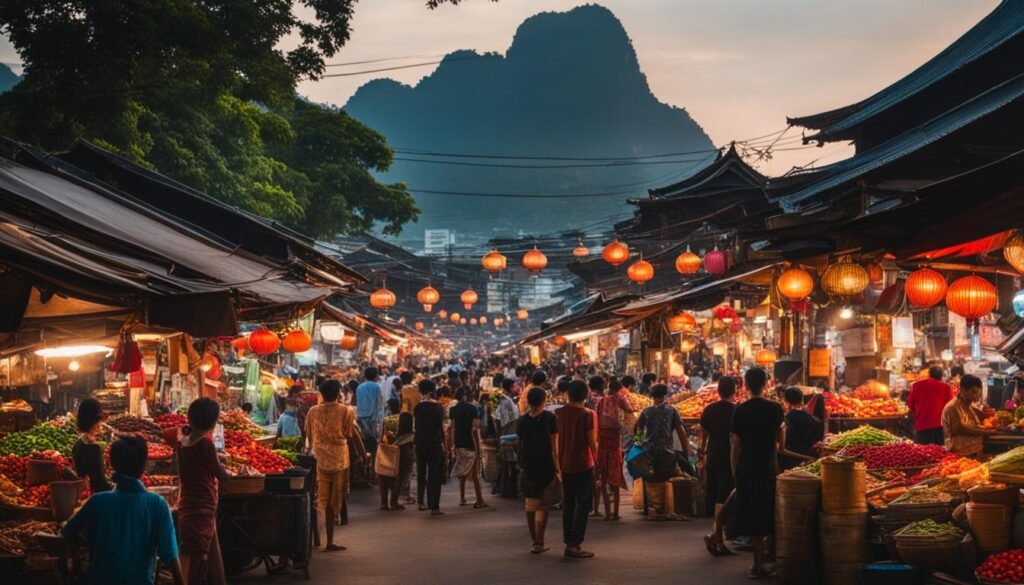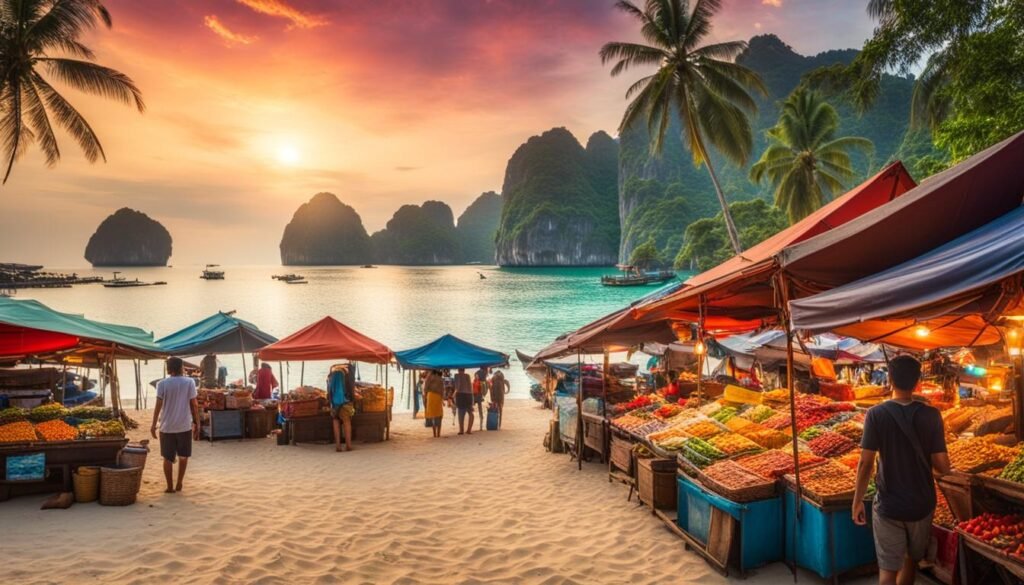Embark on an aromatic journey into the heart of coffee culture in Southeast Asia, where every sip resonates with a storied past and a vibrant present. As you delve into the region’s caffeinated heritage, you’ll discover a tapestry of Southeast Asian coffee traditions that are as diverse as the lands from which they emanate. Savor the intricate flavors and rituals that define coffee in Southeast Asia, an experience steeped in history, community, and innovation.
Key Takeaways
- Exploring the richness of Southeast Asian coffee traditions.
- Understanding the historical context that shaped today’s coffee culture.
- Appreciating the traditional brewing methods unique to different countries.
- Recognizing the role of coffee in uniting communities across Southeast Asia.
- Anticipating the future of coffee in Southeast Asia with its evolving trends and practices.
The Historical Roots of Southeast Asian Coffee Culture
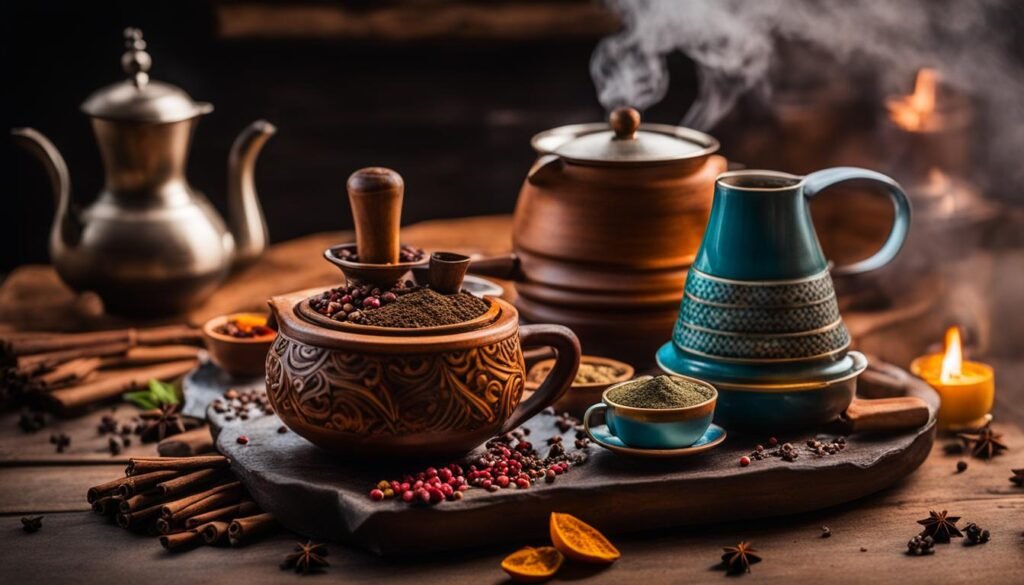
When exploring the intricate tapestry of coffee culture in Asia, we uncover a history as rich and flavorful as the coffee itself. Found in the steaming cups of local brews, an entire narrative unfolds detailing the infusion of traditions and the influence of foreign lands. The historical coffee culture in South East Asia is not merely about the bean, but about the very fabric of its society.
The Arrival of Coffee in Asia: A Brief History
Tracing the arrival of coffee in Asia takes us back to a time when seafaring European traders navigated the spice-route seas. With them came the cherished coffee plant, destined to become a staple in the lush climates of Southeast Asia. Java in Indonesia, part of the then-Dutch East Indies, was one of the first regions where coffee farms flourished, leading to the region being synonymous with coffee even in today’s lexicon.
Asian coffee beans, notably Arabica and later Robusta, found a new home where coffee farming adapted to the local climates. By the 19th century, coffee farming in Asia was a significant part of the rural economy, helping shape the history of coffee culture with every harvest. Philippines, Vietnam, Thailand, and other Asian regions soon followed, integrating coffee cultivation into their agricultural rhythms.
Traditional Coffee Brewing Methods Across Southeast Asia
The traditional coffee brewing methods in Southeast Asia are as varied and distinctive as the cultures themselves. From the complex flavors extracted by the Vietnamese phin to the bold simplicity of the Indonesian tubruk, these techniques showcase a reverence for the craft of coffee making.
It’s the theater of preparation and the patience in brewing that gives traditional Southeast Asian coffee its soul—an antidote to the fast-paced espresso shots of the modern era.
- Vietnam: The slow-drip phin filter produces a rich, intense brew, often served over ice with sweetened condensed milk.
- Indonesia: The tubruk method involves boiling coarse coffee grounds with sugar, creating a strong and sweet concoction.
- Malaysia: The kopi tarik, or “pulled coffee,” is a method where the coffee is poured back and forth between two containers, resulting in a frothy, well-mixed drink.
These coffee traditions in Southeast Asia provide not only a beverage but also an experience, integral to the nation’s daily rhythm and social interactions. Even as modern trends emerge, the contrast of traditional vs. modern coffee practices in Asia demonstrates the balance between innovation and reverence for history.
| Country | Traditional Brewing Method | Modern Alternatives |
|---|---|---|
| Vietnam | Phin | Espresso Machines |
| Indonesia | Tubruk | AeroPress, Pour-over |
| Malaysia | Kopi Tarik | Siphon, French Press |
| Thailand | Oliang | Cold Brew, Drip Bags |
As we delve deeper into the enigmatic world of Southeast Asian brews, we bridge the divide between past and present, experiencing coffee not just as consumers but as partakers in a timeless tradition. Thus, the legacy of Southeast Asian coffee culture continues to steep, infusing the modern coffee scene with layers of history and taste.
Discovering the Regional Coffee Varieties
As you journey through the lush landscapes of Southeast Asia, your senses are greeted by a myriad of regional coffee varieties, each with its own story and taste profile. In this exploration, we will introduce you to some of the most remarkable Southeast Asian coffee varieties and the unique characteristics that make them stand out in the global market. It’s not simply coffee, but a reflection of the region’s rich biodiversity and cultural tapestry.
A crucial component of appreciating these unique coffee blends from Southeast Asia is understanding the diverse growing conditions they thrive in. Varietals such as Arabica, Liberica, and Excelsa, each demand specific altitudes, climates, and soils, all of which are abundant in this equatorial haven. Let’s delve into a deeper appreciation of these beans that have shaped local customs and tantalized palates worldwide.
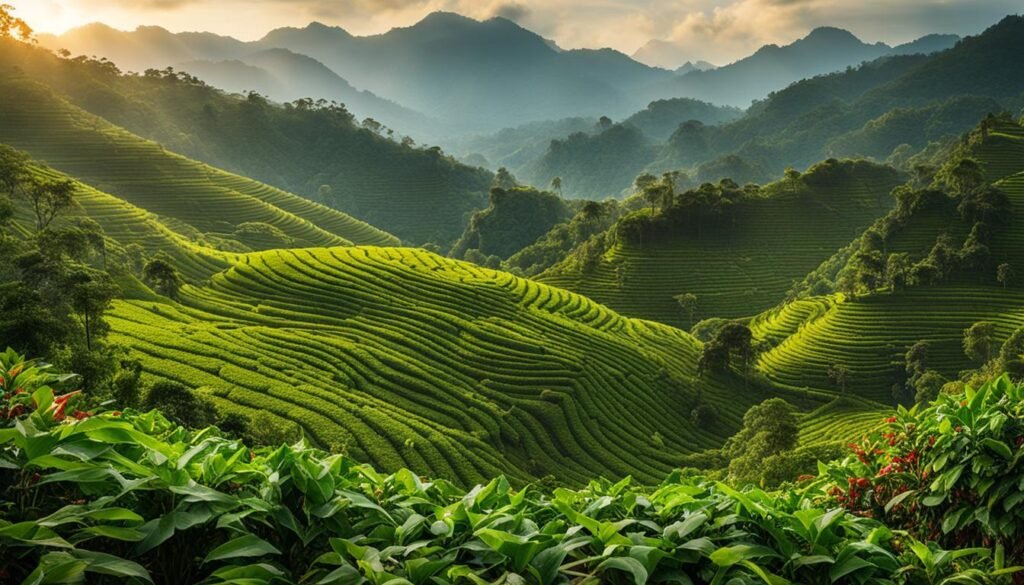
Coffee isn’t just a drink, it’s a diverse palette of flavors that tells a thousand tales of the soils it grew from and the hands that harvested it.
- Arabica (Coffea arabica): Favored for its smoother, sweeter taste with notes of chocolate and sugar, Arabica is often found in the highlands of Vietnam and the mountainous terrains of Indonesia.
- Robusta (Coffea canephora): Known for its stronger, more bitter flavor and higher caffeine content. Robusta thrives in Vietnam’s central highlands, vital to the country’s status as a global coffee powerhouse.
- Liberica (Coffea liberica): With a unique floral and fruity profile, Liberica is a rare treat mostly found in parts of the Philippines, where it’s known as Barako.
- Excelsa (Coffea excelsa): Often used to provide a tart, fruitier layer in blends, Excelsa grows predominantly in Southeast Asia, contributing complexity to the region’s coffee offerings.
Below, discover the nuances of selected Southeast Asian varieties, where you’ll learn about their distinct flavors and the specific regions they’re associated with:
| Variety | Primary Flavors | Notable Regions |
|---|---|---|
| Arabica | Chocolate, Sugar, Fruity Notes | Indonesian Highlands, Vietnamese Highlands |
| Robusta | Bitter, Strong, Earthy | Central Highlands of Vietnam |
| Liberica (Barako) | Floral, Fruity, Woody | Batangas and Cavite, Philippines |
| Excelsa | Tart, Fruity, Creamy Finish | Lake Toba area, Indonesia |
In your quest for taste and knowledge, you’ll discover that these unique coffee blends from Southeast Asia are not just commodities; they’re cultivated art forms, imbued with the essence of their homeland. When you sip on a steaming cup of locally sourced Southeast Asian coffee, take a moment to ponder the journey—from seedling to cup—that has shaped its unique flavor and character.
The Social Fabric of Coffee Culture in Southeast Asia
In Southeast Asia, the coffee culture is far more than a mere routine; it is a woven fabric of society, connecting lives and brewing a sense of community. The morning aroma of freshly brewed coffee from street coffee stalls signifies the beginning of daily life across bustling cities and tranquil villages alike. Here, the influence of coffee in Asian culture is palpable, intertwining itself with the cadence of social interactions and the beat of economic development.
Street Coffee Stalls to Specialty Coffee Shops
The evolution of coffee shops in Southeast Asia tells the dynamic narrative from simple beginnings to sophisticated establishments. Stroll down any street and you might witness the transition in real-time: street coffee stalls, with their modest set-ups, serving local regulars side by side with burgeoning specialty coffee shops. These new havens champion a premium coffee experience where connoisseurs and newcomers alike gather to savor the complexities of a well-crafted brew.
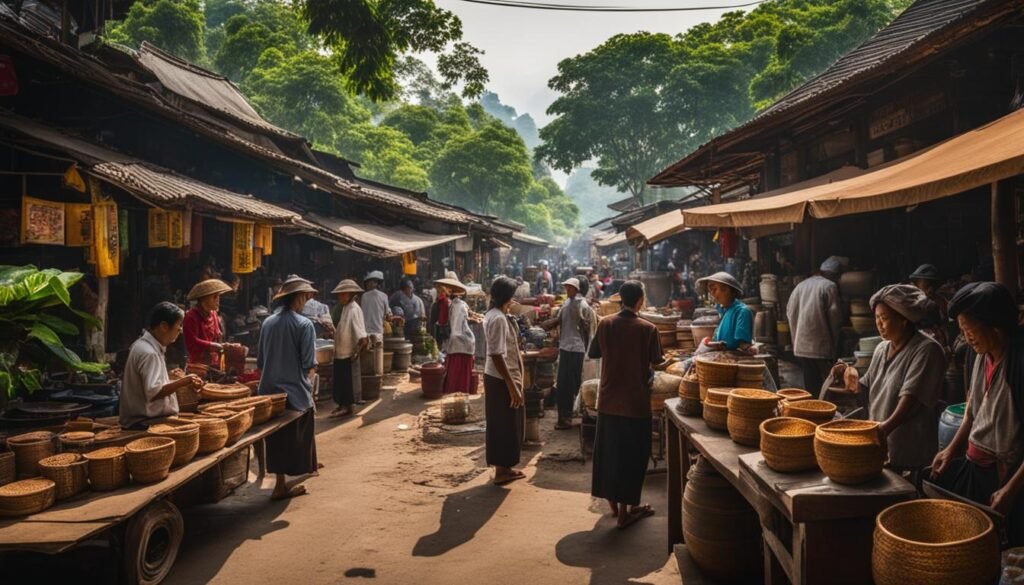
As we follow this metamorphosis, we see not just a shift in locale, but a reinvention of the social fabric. The character of these spaces varies, but the role is constant: coffee as a connective tissue. Whether sipping robusta from a humble stall or indulging in a single-origin pour-over, patrons are part of a shared narrative, contributing to the region’s diverse coffee community impact.
How Coffee Influences Local Communities and Traditions
The coffee influences local traditions in myriad ways, reshaping customs and fostering a unique identity. From a farmer celebrating the harvest with a cup of their finest blend to families gathering in coffee plantations for festive occasions, coffee weaves itself into the cultural cloth. Local coffee customs are respected, and often, the very method of brewing becomes a symbol of regional pride.
With each sip, one can discern the subtle dance of tradition with modernity—a reflection of the region’s ability to honor its roots while embracing new influences.
The coffee culture social aspects are also evident in the way coffee drives economic activity, creating opportunities for both small-scale vendors and entrepreneurs aspiring to elevate the coffee-drinking scene. Through this lens, it becomes clear how coffee not only refreshes but revitalizes communities, reflecting the boundless community and coffee impact within Southeast Asia.
| Aspect of Social Fabric | Influence of Coffee | Example |
|---|---|---|
| Community Spaces | Creates gathering spots for social interaction | Local coffee shops used for meetings and work |
| Economic Activity | Drives local economies and entrepreneurship | Expansion of homegrown coffee brands |
| Cultural Identity | Coffee brewing and consumption customs | Vietnamese phin coffee and Indonesian tubruk |
As you immerse yourself in the lively tapestry of Southeast Asia’s coffee scenes, may you recognize the role of coffee as more than just a beverage—it’s a celebration, a daily ritual, and a testament to the enduring community and coffee Southeast Asia.
The Art of Coffee Roasting and Artisanal Practices in Southeast Asia
As you savor the rich and intricate flavors of a cup of specialty coffee Southeast Asia has to offer, you’re experiencing the culmination of a meticulous craft: coffee roasting Southeast Asia. This transformative process is where the true essence of the coffee bean is unlocked, flavored by the hands and hearts of artisanal roasters across the region. Immersed in tradition yet evolving with modern technique, the roasters honor their heritage while seeking to enhance the profiles of local coffee varieties.
In this part of the world, artisanal coffee Asia stands out for its individualistic and hand-crafted approach to roasting. Roasters operate much like artists, employing their senses to achieve the perfect roast—a balance of time, temperature, and intuition. Each batch is a testament to their dedication, with results that speak to both the tradition embedded in the craft and the modern pursuit of excellence.

Artisanal roasters in Southeast Asia apply a variety of techniques to create distinct flavor profiles that are reflective of their specific localities. From the high-mountain regions to the coastal lowlands, the diversity in elevation, climate, and soil contributes to the complexity found within each bean. Small-batch roasting allows these unique attributes to shine, capturing the spirit of specialty coffee Southeast Asia.
Each bean tells a story, and with artisanal roasting, it’s told with vivid flavor and a reverence for the origin.
Below is an exploration of the roasting techniques that contribute to the influential movement of coffee roasting Southeast Asia, shedding light on the careful process that brings out the best in Asian beans:
| Roasting Technique | Flavor Influence | Common Applications |
|---|---|---|
| Light Roasts | Bright acidity, crisp flavors | Highlighting delicate notes of Arabica beans |
| Medium Roasts | Balanced body and sweetness | Versatile profile suitable for various brewing methods |
| Dark Roasts | Rich and bold, less acidity | Accentuating the intensity of Robusta beans |
| Blend Roasts | Complex, tailored flavor profiles | Crafting exclusive signature blends |
These roasting methods form the bedrock upon which the traditional and artisanal coffee Asia scene thrives. The detailed attention imbued into every stage—from bean selection to cooling the roast—ensures a product that is not only consistent but also dynamic in its taste experience.
- Bean Selection: Sourcing prime quality beans with desirable characteristics.
- Roast Profiling: Determining the optimal roast curve for each bean variety.
- Roasting Process: Carefully monitoring the development of flavors in the roast.
- Cooling: Rapidly stopping the roasting process at the precise moment to lock in flavors.
- Quality Assurance: Cupping sessions to ensure the roast meets high standards.
Artisanal roasting in the region has seen a resurgence, with an emphasis on specialty coffee Southeast Asia markets seek. As awareness and appreciation of coffee complexities grow, so does the spotlight on the roasters who are pushing the boundaries of craftsmanship to newfound heights. Their relentless pursuit to perfect the roast is woven deeply into every cup you enjoy, echoing the soul of Southeast Asia’s vibrant culture.
Modern Trends: The Evolution of Coffee Culture in the Region
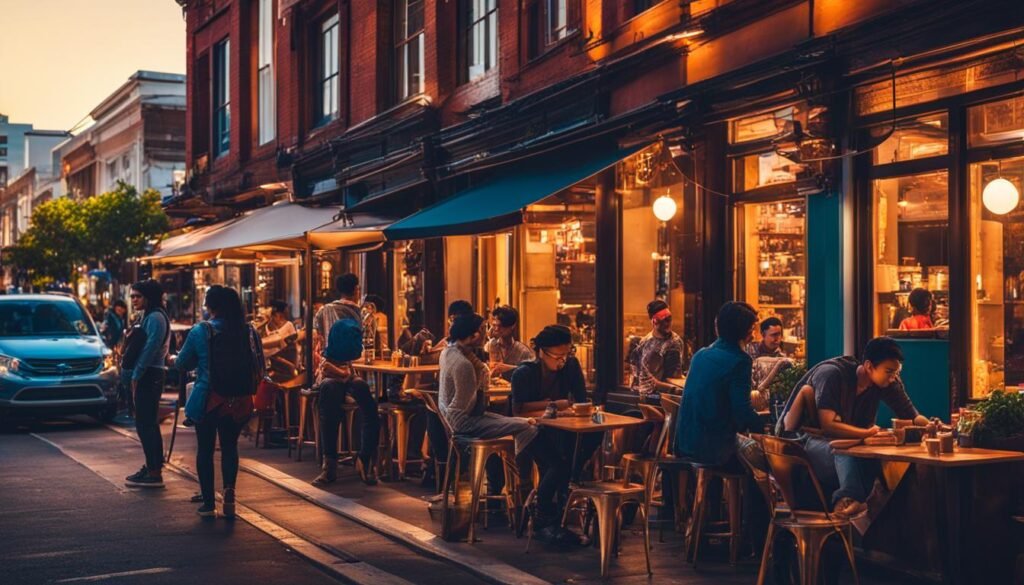
In the aromatic labyrinth of Southeast Asia’s coffee landscape, the evolution of modern coffee culture trends Southeast Asia reverberates through every cup served. The Western influence on coffee consumption has introduced a variety of practices to the region, offering a contrast of styles from traditional robustas to crafted lattes. This has marked a significant shift as part of the transitioning coffee culture, where global impact on local coffee culture is seen in the emergence of high-end cafes and specialty roasters.
From Traditional to Modern: Coffee Consumption Trends
Amidst the hustle of Southeast Asia’s vibrant streets, a new wave of coffee consumption trends is brewing. The younger generation, in particular, has embraced modern coffee practices in Asia, wherein international chains and specialty cafes serve as social hubs. As the coffee culture transitions, we notice an increasing inclination towards sustainability, with direct-trade practices and organic coffee becoming more popular.
Let’s take a look at how these trends manifest in coffee consumption patterns:
| Traditional Practices | Modern Preferences |
|---|---|
| Local brews like Vietnamese Phin coffee | Western-inspired espresso-based drinks |
| Drinking coffee as a social activity at local stalls | Frequenting specialty coffee shops for the ambiance |
| Preference for sweetened and strong coffee | Growing taste for specialty beans and black coffee |
The juxtaposition of regional coffee rituals with the advent of contemporary coffeehouses points to a contrast of Asian coffee styles. The rich, sweetened traditional brews continue to coexist with the third-wave coffee movement’s lighter roasts and artisanal techniques, enriching the tapestry of the region’s coffee scene.
Impact of Global Coffee Demand on Local Economy and Culture
With a steamy coffee in hand, you might not realize the global coffee demand effects that resonate in the very grounds of your cup. Indeed, the rising appetite for coffee contributes significantly to the coffee’s role in Southeast Asian economy, uplifting local communities and invigorating the agricultural sector.
However, the surge in demand does not come without its challenges:
As specialty coffee grows in popularity, traditional farming methods, and by extension cultural practices, are often pressured to change to meet global standards.
Consider the table below which encapsulates this paradigm shift:
| Global Impact | Economic Effect | Cultural Shift |
|---|---|---|
| Increased international demand for coffee | Boost to local economies and GDP | Greater emphasis on coffee quality and sustainability |
| Proliferation of Western-style coffee chains | Employment opportunities and urbanization | Advent of globalized coffee consumer culture |
| Shift towards artisanal and organic coffee practices | Market diversification and potential for premium pricing | Introduction of new coffee styles and fusion cuisine |
The coffee and cultural change in Southeast Asia is thus twofold, where the stimulant of the economy is met with a new dimension of cultural exchange. From the cultivation of local beans to the eclectic urban coffee spots, the ebb and flow of tradition with globalization is evident in each layer of the region’s coffee culture.
Through your interactions with the modern brews of Asia, indulge in the knowledge that every sip is a blend of the old and the new—a testament to an ever-evolving, yet perennially rich coffee heritage.
Conclusion
As we wrap up this aromatic voyage, the coffee culture Southeast Asia summary we’ve embraced circles back to its profound roots and extends to the promise of its future. A journey through time and taste has revealed the historical significance—how coffee, once a trader’s treasure, became entwined with the very essence of Southeast Asian life. Alongside bustling markets and serene plantations, we’ve observed coffee’s pivotal role in shaping social strata, forging community bonds, and influencing daily rituals that resonate across the region.
The task of preserving coffee culture while seizing the innovative spirit of modernity emerged as a leitmotif throughout our explorations. Here, the balance is delicate: venerating age-old traditions while also embracing coffee diversity and evolution. This duality reminds us that while trends shift like sands, the core of Southeast Asian coffee culture remains steadfast in its ability to adapt and enchant.
Your insight into this intricate tableau of culture, community, and caffeine cultivates a deeper appreciation for every cup you encounter—stirring within it a reverent nod to history and a hopeful gaze toward an ever-diverse horizon. As the final droplet of this narrative experience tapers off, may you carry with you the richness of Southeast Asia’s coffee narrative, steeped in tradition and brimming with anticipation for what each future brew might hold.
FAQ
What are some unique coffee traditions in Southeast Asia?
Southeast Asia is home to a variety of unique coffee traditions, such as the Vietnamese “phin” filter drip coffee, the Indonesian “kopi tubruk” where coffee is boiled with sugar, and the Thai iced coffee that combines strong brew with sweetened condensed milk.
How did coffee first arrive in Southeast Asia?
Coffee was introduced to Southeast Asia by European colonists and traders in the 17th century. Countries like Indonesia became some of the earliest places for coffee plantation outside of the Arab world and Ethiopia due to Dutch colonialism.
What are the traditional coffee brewing methods in Southeast Asia?
Traditional brewing methods vary by country, but common practices include using a cloth filter in the traditional Thai “Oliang”, the aforementioned Vietnamese “phin” drip filter, and the Indonesian practice of brewing coffee directly in the cup with grounds and hot water (“kopi tubruk”).
Are there unique regional coffee varieties found in Southeast Asia?
Yes, Southeast Asia is known for regional varieties such as the Arabica beans grown in the highlands of Vietnam, the robusta beans prevalent in Indonesia, and the Liberica beans, a rarer variety found in the Philippines.
How important are coffee shops and street stalls in Southeast Asia?
Coffee shops and street stalls are central to the coffee culture in Southeast Asia, serving as social hubs for both urban dwellers and rural communities. They’re places for social interaction, business meetings, and relaxation.
How is the local community influenced by coffee culture?
Local communities are deeply influenced by coffee culture; it’s woven into the fabric of daily life, from traditional ceremonies to the economy. Coffee plays a significant role in creating a sense of community and unity.
What distinguishes coffee roasting in Southeast Asia from other regions?
Southeast Asian coffee roasting often emphasizes artisanal practices, using traditional techniques and equipment to bring out unique tastes and flavors specific to the local terroir, differentiating them from more industrialized roasting methods elsewhere.
How is coffee culture evolving in Southeast Asia?
Coffee culture in Southeast Asia is blending traditional methods with modern trends, including the rise of specialty coffee shops, an increased focus on sustainable and ethical production, and the adoption of global coffee-making practices like using espresso machines and cold brew techniques.
What impact has global coffee demand had on Southeast Asia?
Global coffee demand has boosted the Southeast Asian economy through increased exports, but it also poses challenges like stressing local ecosystems and influencing cultural change. There’s a balance between embracing growth and preserving traditional practices and sustainability.


